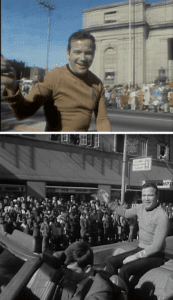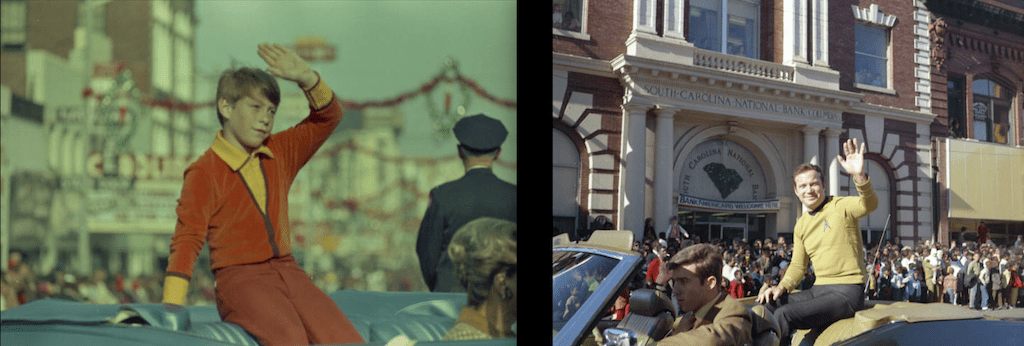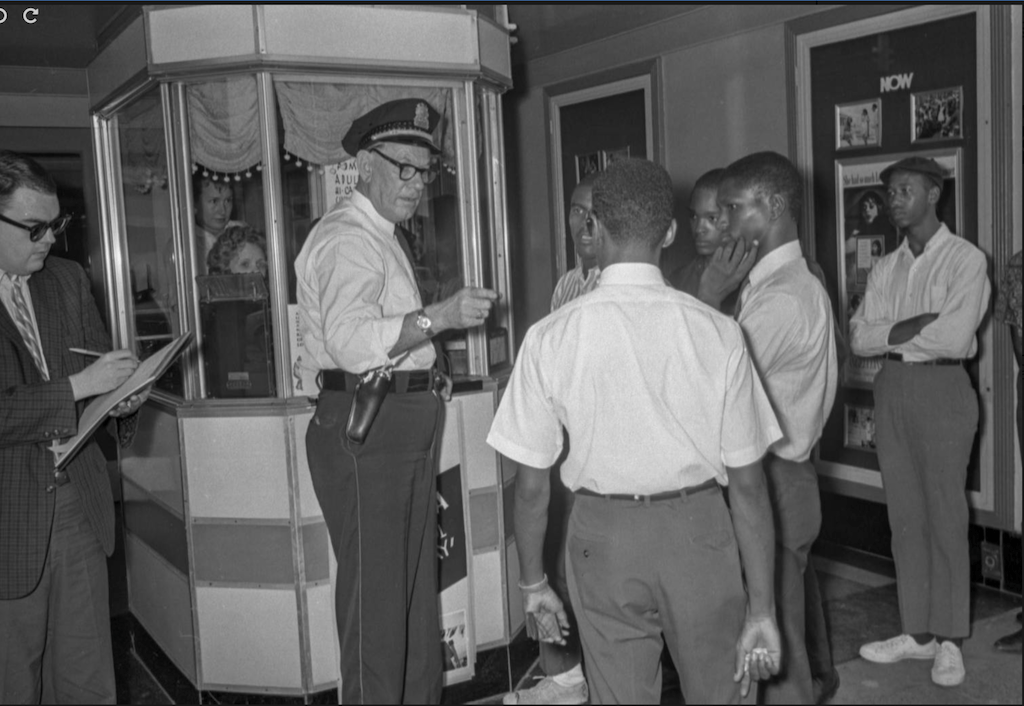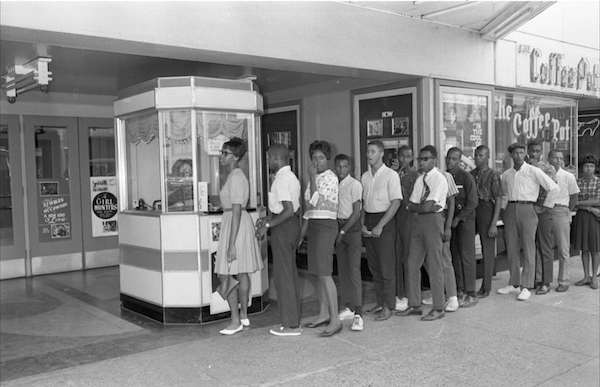Orphans in Space: Forgotten Films from the Final Frontier
special edition for Roger That! 2021
 Carillon (Christmas) Parade (WIS and WNOK, 1968)
Carillon (Christmas) Parade (WIS and WNOK, 1968)
5 min., b/w and color, silent
Source: University of South Carolina Moving Image Research Collections @USCMIRC
The term newsfilm became increasingly common in the television age, referring less often to newsreels than to 16mm footage shot for TV networks and local stations. Film remained the medium for newsgathering through the 1970s. As videotape replaced celluloid many stations jettisoned their older newsfilm. Libraries and archives have often taken in large quantities of these reels. Now millions of feet of fragmentary material must be managed.
The University of South Carolina created its Newsfilm Library in 1980 with the acquisitions of its Fox Movietone newsreel collection and the lesser-known C. E. Feltner Jr. Collection, thousands of cans of miscellaneous footage, donated by the head of the Krypton [!] Corporation. Donations of local newsfilm followed, from Columbia stations WIS (16mm material from 1959-78) and WNOK (1966-76).
The five-minute sample on the 2012 DVD combines two pieces labeled Carillon (Christmas) Parade, shot simultaneously on November 29, 1968. WIS filmed in color; WNOK, black and white. Here is the latter.
William Shatner, in Starfleet costume, enters at 1:30 into the 2:25 clip. The video is part of the new catalog system for digital collections at USC Libraries. The descriptive record is here. Note the item is now assigned the title Christmas parade — outtakes, WLTX News Story 486. (WLTX became the calls letters for WNOK with new ownership in 1977.) The annual event continues to use the name Carillon Parade since its origin in 1953. The name (a bit puzzling even to locals) was chosen via a newspaper contest. The winning entry suggested the new fall festival be called carillon, using a double wordplay. In addition to resembling Carolina, it is the name of a bell tower musical instrument — and belles would be entering the event’s beauty contest. (See below.)
The footage here illustrates the idiosyncratic nature of newsfilm collections. Parade scenes, a staple of nonfiction film since its birth, mixes banal ritual and novelty. The contrasts can be sublime.
Although we don’t have access to the color footage from WIS-TV, here is the 2012 voiceover for the 5-minute DVD mix.
Marching bands, Shriners, clowns, local dignitaries, papier-mâché floats, flags, and beauty queens are the generic Main Street paraders on screen. But the unexpected presence of national celebrity William Shatner, dressed as Star Trek‘s Captain Kirk, enlivens the content. Star Trek was in the midst of its third and final television season on NBC; in hindsight, we know its run as the most important space travel narrative of all, was just beginning. Curious, then, that we see in the footage a pair of fans rushing Shatner’s convertible limousine. Could these be among the earliest Trekkies captured in action, on film? (The term had been coined the previous year, as early devotees were already noted in the media.)
Shatner’s presence as grand marshal appears to have been a contractual obligation with NBC. His Carillon Parade predecessors were actors from other NBC series (Lorne Green, Michael Landon), and WIS was the state’s key NBC affiliate.

Given the deep racial divide in South Carolina and the heightened tensions of ’68, Shatner’s arrival came at a conspicuous moment. That very week’s episode of Star Trek featured American television’s first inter-racial kiss, between Captain Kirk and Lieutenant Uhura (played by African American actress Nichelle Nichols).
With its incidental shots of public spaces filled with citizens both black and white, casually interacting, this small piece of newsfilm demonstrates the documentary value of even seemingly prosaic recordings. Film historians we might also note the Columbia Main Street movie theaters seen in several shots. In September 1963, NAACP-led protests against the racial segregation of these venues succeeded. The University of South Carolina’s first African American students since Reconstruction enrolled that same week.


 Photos from The State Newspaper Photograph Collection, Richland Library.
Photos from The State Newspaper Photograph Collection, Richland Library.
The same blocks of Main Street were also the site of 1960 lunch counter sit-ins by Black citizens fighting Jim Crow segregation. Such tensions are invisible in the silent 1968 newsfilm shot on the same location. We see shots of both inter-racial groupings and racially separated ones. Of the four marching bands, two are racially integrated; one all white (and carrying a Confederate flag alongside American, state, and school banners) and another from historically Black Booker T. Washington High School.

In recent years, USC MIRC discovered reels of historic local news footage related to Columbia’s desegregation battles. An online database — Civil Rights Films — features 197 items documenting South Carolina 1960 to 1968.
On the subject of outer space travel and civil rights, we can note that a year before this high school marching band footage was shot future NASA astronaut Ronald McNair (1950-1986) graduated from Carver High in his hometown of Lake City, South Carolina.
“The road between South Carolina and space flight is not a very simple one, nor is it one filled with guarantees.” In 1984, two years before his death onboard the Space Shuttle Challenger, McNair delivered the commencement address at the University of South Carolina.
Preservation note
The university’s Local Television News Collections comprise some 1.5 million feet of 16mm newsfilm, with hundreds of pieces online in its searchable database. In addition to news footage, the WIS-TV material includes film shot for the magazine program Black Awareness (1979-80).
+
NASA / MIRC / Newsfilm bonus item
An added value of local TV collections is their demonstrated integration with national news feeds and use of free, self-interest press released. Here, for example, is an excerpt from Flight plan of Apollo XI–handout, WLTX News Story 141 (Aug. 18, 1969), silent footage NASA gave (a “handout”) to broadcasters for local use. View the full 4:11 with the descriptive record at MIRC.
—
Dan Streible researched local movie exhibition history while teaching at the University of South Carolina in Columbia (1997-2006). Andrew Murdoch, founding archivist at the university’s Newsfilm Library, brought the William Shatner footage to his attention.

The Columbia Record, March 25, 1953, 1. (Provided Katharine Allen of Historic Columbia.)
